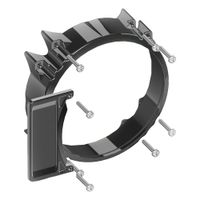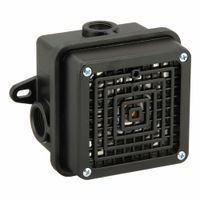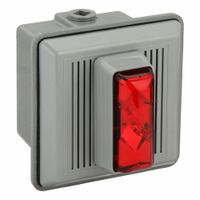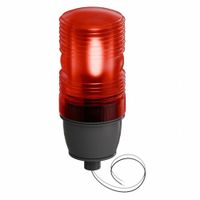Call +(254) 703 030 000 / 751 483 999 / 721 704 777
.....Read More
Frequently Asked Questions
What are the different types of safety alarms and warning lights?
Safety alarms and warning lights are crucial for alerting individuals to potential hazards. They come in various types, each designed for specific situations:
1. **Fire Alarms**: These detect smoke, heat, or flames and emit loud sounds to alert occupants of a fire. They often include visual signals like flashing lights for the hearing impaired.
2. **Carbon Monoxide Detectors**: These alarms detect the presence of carbon monoxide gas, which is odorless and colorless, providing an audible alert to prevent poisoning.
3. **Intrusion Alarms**: Used in security systems, these alarms detect unauthorized entry into a building or area, often triggering sirens and alerting security personnel.
4. **Gas Leak Detectors**: These alarms identify leaks of gases like natural gas or propane, providing early warnings to prevent explosions or poisoning.
5. **Emergency Warning Lights**: Used on vehicles like ambulances, police cars, and fire trucks, these lights alert other drivers to yield or make way for emergency response.
6. **Industrial Warning Alarms**: Found in factories, these alarms signal machinery malfunctions, chemical spills, or other industrial hazards, often accompanied by flashing lights.
7. **Weather Alert Systems**: These alarms provide warnings for severe weather conditions like tornadoes or hurricanes, often through sirens or broadcast alerts.
8. **Medical Alert Systems**: Used by individuals with health issues, these systems allow users to summon help in emergencies, often with wearable devices that trigger alarms.
9. **Building Evacuation Alarms**: These systems guide occupants to safety during emergencies like fires or earthquakes, using both audible and visual signals.
10. **Personal Safety Alarms**: Portable devices that emit loud sounds to deter attackers or attract attention in emergencies.
Each type of alarm and warning light is designed to ensure safety by providing timely alerts and facilitating appropriate responses to various hazards.
How do audible alarms work?
Audible alarms function by converting electrical energy into sound energy to alert individuals to a specific condition or hazard. They typically consist of several key components: a sensor or trigger mechanism, a control unit, and a sound-producing device such as a speaker or siren.
1. **Sensor/Trigger Mechanism**: This component detects specific conditions that warrant an alarm, such as smoke, motion, or unauthorized entry. Sensors can be based on various technologies, including infrared, ultrasonic, or photoelectric.
2. **Control Unit**: Once the sensor detects a triggering event, it sends a signal to the control unit. The control unit processes this signal and determines whether the conditions meet the criteria for activating the alarm. It may include logic circuits or microcontrollers to handle complex decision-making processes.
3. **Sound-Producing Device**: Upon receiving a signal from the control unit, the sound-producing device generates an audible alert. This device can be a piezoelectric buzzer, electromagnetic horn, or speaker. The sound is produced by creating rapid vibrations in the air, which are perceived as sound waves by the human ear.
The alarm's sound characteristics, such as volume, frequency, and pattern, are designed to ensure they are noticeable and convey urgency. Some alarms use continuous tones, while others use intermittent patterns to attract attention more effectively.
Audible alarms are powered by electrical sources, such as batteries or direct electrical connections, ensuring they function even during power outages. They are often integrated into larger security or safety systems, providing a critical layer of protection by alerting individuals to take necessary actions in response to potential threats or emergencies.
What are the benefits of using visual alerts in safety systems?
Visual alerts in safety systems offer several benefits:
1. **Immediate Recognition**: Visual alerts provide instant recognition of hazards or system statuses, allowing for quick response and decision-making.
2. **Non-Intrusive**: Unlike auditory alarms, visual alerts can be less disruptive, allowing individuals to maintain focus on tasks while still being aware of potential dangers.
3. **Accessibility**: They are accessible to individuals with hearing impairments, ensuring inclusivity in safety measures.
4. **Clarity and Specificity**: Visual alerts can convey specific information through colors, symbols, or text, reducing ambiguity and enhancing understanding of the situation.
5. **Persistent Notification**: Unlike sound, which can be missed or ignored, visual alerts remain visible until acknowledged, ensuring continuous awareness.
6. **Environmental Suitability**: In noisy environments, visual alerts are more effective as they are not drowned out by background noise.
7. **Reduced Alarm Fatigue**: By complementing auditory alarms, visual alerts can help reduce alarm fatigue, where individuals become desensitized to constant noise.
8. **Enhanced Communication**: They can be used to communicate complex information quickly, such as evacuation routes or emergency procedures, through diagrams or flashing lights.
9. **Customization**: Visual alerts can be tailored to specific environments or situations, using different colors or patterns to indicate varying levels of urgency.
10. **Integration with Technology**: They can be easily integrated with digital systems, allowing for automated updates and real-time monitoring.
11. **Psychological Impact**: Visual cues can have a calming effect, as they provide clear guidance and reassurance during emergencies.
Overall, visual alerts enhance the effectiveness of safety systems by providing clear, accessible, and immediate information, improving response times and ensuring a safer environment.
How do combination audible and visual alarms enhance safety?
Combination audible and visual alarms enhance safety by providing multiple sensory cues that increase the likelihood of alerting individuals to potential hazards. This dual-modality approach ensures that even if one sense is compromised, the other can still effectively communicate the warning.
Audible alarms are effective in capturing attention through sound, which can be heard over distances and through obstacles. They are particularly useful in noisy environments where visual cues might be missed. Different tones, volumes, and patterns can convey varying levels of urgency, prompting immediate action.
Visual alarms, such as flashing lights or color-coded signals, provide a clear and direct indication of danger. They are crucial in environments where noise levels are high, hearing protection is used, or for individuals with hearing impairments. Visual signals can be designed to be noticeable even in peripheral vision, ensuring they are seen even if not directly looked at.
The combination of both audible and visual alarms caters to diverse needs and situations, ensuring that warnings are accessible to everyone, including those with sensory impairments. This redundancy increases the reliability of the alert system, reducing the risk of missed warnings.
Moreover, the integration of both types of alarms can help in prioritizing responses. For instance, a simultaneous loud siren and flashing red light might indicate an immediate evacuation, while a softer tone with a steady light could signal a less urgent issue.
In summary, combination audible and visual alarms enhance safety by providing comprehensive, multi-sensory alerts that are more likely to be noticed and understood, thereby facilitating quicker and more effective responses to potential dangers.
What accessories are available for audible alarms?
Accessories for audible alarms enhance functionality, improve user interaction, and ensure effective alerting. Key accessories include:
1. **Strobe Lights**: These provide visual alerts alongside audible signals, crucial in noisy environments or for individuals with hearing impairments.
2. **Remote Controls**: Allow users to arm, disarm, or test alarms from a distance, offering convenience and flexibility.
3. **Battery Backups**: Ensure alarm functionality during power outages, maintaining security and alert capabilities.
4. **Wireless Transmitters and Receivers**: Enable integration with other security systems or devices, facilitating seamless communication and control.
5. **External Speakers**: Amplify alarm sounds, extending the audible range to cover larger areas or outdoor spaces.
6. **Keypads**: Provide a user interface for programming and controlling alarm settings, often featuring backlit displays for visibility in low light.
7. **Mounting Brackets and Enclosures**: Offer secure installation options and protection against environmental factors, enhancing durability.
8. **Sounders and Sirens**: Available in various tones and volumes, these can be customized to suit specific alert requirements or preferences.
9. **Vibration Sensors**: Detect physical disturbances, triggering alarms in response to tampering or unauthorized access attempts.
10. **Integration Modules**: Allow connection with smart home systems or other security devices, enabling centralized control and monitoring.
11. **Testers and Simulators**: Facilitate regular maintenance and testing, ensuring alarms function correctly and reliably.
12. **Volume Controls**: Enable adjustment of alarm sound levels to suit different environments or user needs.
These accessories enhance the effectiveness, usability, and integration of audible alarm systems, catering to diverse security and alerting requirements.
How can I protect alarm system components from damage?
To protect alarm system components from damage, consider the following strategies:
1. **Weatherproofing**: Use weather-resistant enclosures for outdoor components to shield them from rain, snow, and extreme temperatures. Ensure all seals and gaskets are intact.
2. **Surge Protection**: Install surge protectors to guard against electrical surges that can damage sensitive electronics. This is especially important in areas prone to lightning strikes.
3. **Physical Barriers**: Use tamper-proof covers and enclosures to prevent vandalism or accidental damage. Secure components with locks or screws that require special tools to remove.
4. **Regular Maintenance**: Conduct routine inspections and maintenance to identify and address wear and tear. Replace batteries and faulty components promptly to ensure system reliability.
5. **Proper Installation**: Ensure components are installed according to manufacturer guidelines. Avoid placing them in areas prone to physical impact or where they can be easily accessed by unauthorized individuals.
6. **Environmental Controls**: Maintain a stable environment for indoor components by controlling humidity and temperature. Use dehumidifiers or air conditioning if necessary.
7. **Cable Management**: Protect wiring from physical damage by using conduits or cable trays. Avoid running cables through high-traffic areas where they can be tripped over or snagged.
8. **Backup Power**: Install backup power sources, such as batteries or generators, to keep the system operational during power outages, preventing potential damage from abrupt shutdowns.
9. **Software Updates**: Regularly update the system’s software to protect against vulnerabilities that could be exploited to disable or damage the system.
10. **Professional Monitoring**: Consider professional monitoring services that can provide immediate response to system alerts, potentially preventing damage from ongoing threats.
Implementing these measures can significantly enhance the durability and reliability of your alarm system components.
What are the fire code requirements for fire alarms and strobes?
Fire code requirements for fire alarms and strobes are primarily governed by the National Fire Protection Association (NFPA) standards, particularly NFPA 72, the National Fire Alarm and Signaling Code. Key requirements include:
1. **Installation and Placement**: Fire alarms and strobes must be installed in accordance with the building's occupancy type and layout. Alarms should be placed in areas where they can be heard throughout the building, while strobes should be visible from all areas, including restrooms and corridors.
2. **Sound Levels**: Audible alarms must produce a sound level that is at least 15 decibels above the average ambient sound level or 5 decibels above the maximum sound level having a duration of at least 60 seconds, whichever is greater.
3. **Strobe Intensity and Coverage**: Strobes must have a minimum intensity of 15 candela and be spaced to ensure visibility throughout the building. The intensity and spacing are determined by room size and configuration.
4. **Synchronization**: In areas where multiple strobes are visible, they must be synchronized to flash simultaneously to prevent disorientation.
5. **Power Supply**: Fire alarm systems must have a reliable primary power source and a backup power source, typically batteries, to ensure functionality during power outages.
6. **Testing and Maintenance**: Regular testing and maintenance are required to ensure the system's operational integrity. This includes monthly visual inspections, annual functional testing, and periodic maintenance as specified by the manufacturer and NFPA 72.
7. **Accessibility**: Systems must comply with the Americans with Disabilities Act (ADA), ensuring that alarms and strobes are accessible to individuals with hearing or visual impairments.
8. **Documentation and Record Keeping**: Proper documentation of system design, installation, testing, and maintenance must be maintained for inspection and compliance verification.
These requirements ensure that fire alarm and strobe systems effectively alert occupants in the event of a fire, facilitating timely evacuation and enhancing safety.
How do I choose the right safety alarm for my facility?
1. **Assess Facility Needs**: Determine the specific safety requirements of your facility. Consider the size, layout, and type of operations conducted. Identify potential hazards and areas that require monitoring.
2. **Understand Alarm Types**: Familiarize yourself with different alarm types such as fire alarms, carbon monoxide detectors, intrusion alarms, and panic alarms. Each serves a specific purpose and may be necessary depending on your facility's needs.
3. **Compliance and Standards**: Ensure the alarm system complies with local regulations and industry standards. Check for certifications and approvals from relevant authorities to guarantee reliability and effectiveness.
4. **Integration Capabilities**: Choose an alarm system that can integrate with existing security and safety systems. This includes compatibility with surveillance cameras, access control systems, and emergency communication systems.
5. **Scalability**: Select a system that can grow with your facility. As your operations expand, the alarm system should be able to accommodate additional sensors and devices without requiring a complete overhaul.
6. **Ease of Use**: Opt for a user-friendly system that staff can easily operate and understand. Training should be straightforward to ensure quick response in emergencies.
7. **Maintenance and Support**: Consider the availability of technical support and maintenance services. Regular maintenance is crucial for the system's reliability and longevity.
8. **Cost**: Evaluate the total cost of ownership, including installation, maintenance, and potential upgrades. Balance cost with the level of protection and features offered.
9. **Vendor Reputation**: Research vendors and choose one with a strong reputation for quality and customer service. Read reviews and seek recommendations from other facility managers.
10. **Trial and Testing**: If possible, conduct a trial run of the alarm system to assess its performance and suitability for your facility before making a final decision.
What maintenance is required for safety alarms and warning lights?
Maintenance for safety alarms and warning lights involves several key steps to ensure they function correctly and provide reliable alerts in emergencies:
1. **Regular Testing**: Conduct routine tests to verify that alarms and lights are operational. This includes activating alarms to check sound levels and ensuring lights illuminate properly.
2. **Battery Checks**: Inspect and replace batteries regularly, especially in battery-operated devices. Follow manufacturer recommendations for battery replacement intervals.
3. **Visual Inspections**: Perform visual inspections to identify any physical damage, corrosion, or wear and tear. Ensure that all components are securely mounted and free from obstructions.
4. **Cleaning**: Clean alarms and lights to remove dust, dirt, and debris that could impair functionality. Use appropriate cleaning agents and methods to avoid damage.
5. **Software Updates**: For systems with digital components, ensure that software and firmware are up to date to maintain compatibility and security.
6. **Calibration**: Some alarms, like gas detectors, require periodic calibration to ensure accuracy. Follow manufacturer guidelines for calibration frequency and procedures.
7. **Documentation**: Keep detailed records of all maintenance activities, including dates, findings, and actions taken. This helps track performance and identify recurring issues.
8. **Professional Servicing**: Engage qualified technicians for complex maintenance tasks or when issues are beyond in-house capabilities. Regular professional inspections can identify potential problems early.
9. **Compliance Checks**: Ensure that all alarms and lights meet relevant safety standards and regulations. Update systems as necessary to comply with new requirements.
10. **Training**: Provide training for personnel responsible for maintenance to ensure they understand procedures and safety protocols.
By adhering to these maintenance practices, safety alarms and warning lights can remain reliable and effective, minimizing the risk of failure during critical situations.
How do I troubleshoot issues with safety alarms and warning lights?
1. **Identify the Alarm/Warning Light**: Check the vehicle or equipment manual to understand what each alarm or warning light signifies.
2. **Check for Obvious Issues**: Inspect for visible problems such as loose wires, blown fuses, or low fluid levels.
3. **Consult the Manual**: Refer to the troubleshooting section of the manual for specific guidance related to the alarm or warning light.
4. **Reset the System**: Turn off the equipment or vehicle, wait a few minutes, and restart to see if the alarm or light resets.
5. **Diagnostic Tools**: Use an OBD-II scanner or other diagnostic tools to read error codes and identify specific issues.
6. **Inspect Sensors**: Check sensors related to the alarm or warning light for dirt, damage, or disconnection.
7. **Software Updates**: Ensure that the system software is up to date, as updates can resolve known issues.
8. **Check Battery and Connections**: Ensure the battery is charged and connections are secure, as low power can trigger false alarms.
9. **Consult a Professional**: If the issue persists, seek help from a qualified technician or service center.
10. **Document the Issue**: Keep a record of the alarms, conditions when they occur, and any steps taken to resolve them for future reference.




